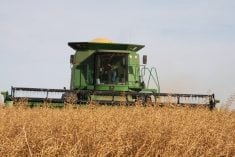Applying nitrogen fertilizer at the time of planting in spring is usually the best option for most Prairie farmers. But that means applying a lot of product, which can really slow down the seeding process. Getting the seed in the ground at the optimum time is important, and delays can reduce crop yield potential. Some farmers are weighing the advantages and disadvantages of applying all nitrogen fertilizer at seeding with other options.
One option to consider is banding N fertilizer in late fall. But keep in mind that fall N application can range from very effective to very disappointing. Effectiveness depends on environmental conditions after application including soil moisture and temperature.
Read Also

Claas brings 1000 Series SP forage harvesters to Canada
In mid-August, Claas unveiled its new line of Jaguar forage harvesters at an event in Visalia, California, deep in the heart of that state’s dairy region.
The products
The two best fertilizers for fall application are urea 46-0-0 CO(NH2)2 and anhydrous ammonia 82-0-0 NH3. When urea or anhydrous ammonia are banded into moist soil, both convert to ammonium NH4+. Ammonium is positively charged and is relatively immobile in soil and will not leach under wet conditions. In warm, moist soil, specific bacteria will convert ammonium to nitrate [NO3-] over a several week period. This process is called nitrification.
Nitrate is negatively charged, is mobile in soil and will leach with excess precipitation, particularly in sandy soils and can be loss to denitrification (gaseous loss of N in very, wet soil).
Banding ammonia or urea creates an environment within the band that slows the activity of soil bacteria that convert ammonium to nitrate, delaying nitrification. When urea or anhydrous ammonia are banded in late fall after the soils have cooled in temperatures less than 5 C to 7 C and micro-organism activity has slowed, most of the fertilizer N will be remain in the ammonium form over winter until the soil warms up in the spring. The ammonium form is relatively stable and won’t leach or denitrify.
If urea is broadcast and incorporated or banded in early fall when soils are still warm and moist, much of the ammonium can potentially be converted to nitrate before freeze-up. Excess precipitation in late fall or spring could then cause the nitrate to leach below the crop root zone, particularly in sandy soils or be lost due to denitrification. The denitrification process occurs when N fertilizer has converted to nitrate, soil conditions become very wet or saturated after snow melt in spring or due to heavy precipitation events. Soil N is lost when soil microorganisms in anaerobic conditions (very wet soil without oxygen) convert nitrate-N to nitrous oxide — a gaseous form of N that is lost to the atmosphere.
All soil types and regions of the Prairies are susceptible to losses of fall-applied N fertilizer. However, the risk of N loss is highest in regions with moister climates when soils can be very wet, such as the black and gray soil zones, and risk is lowest in regions that tend to be drier, such as the brown and dark brown soil zones.
Alberta research has shown that nitrate losses through denitrification in drier regions are usually low, and fall-banded N is usually equally effective to spring-banded N. But if spring wet conditions occur, N losses can still be high even in low risk regions, after heavy precipitation events. Each fall, a farmer must look at specific local environment conditions to weigh the risks versus benefits of fall fertilizer application.
Some issues to consider:
- Late fall-banded N can be as effective as spring banded N, if there is no extended period of very wet or saturated soil conditions in the spring.
- Early fall application of N fertilizer has a greater chance of converting to nitrate-N before freeze-up and would be more susceptible to N loss in the spring.
- Fall-banded N can be more effective than spring-banded N when springtime seedbed moisture is limited, and spring banding would dry out the seed-bed.
- Fall-banded N can be less effective than spring-banded N when spring moisture is wet for extended periods.
- Fall fertilization shifts workload from the hectic spring to the fall. This can increase spring seeding operation efficiency.
- Nitrogen fertilizer prices tend to be lower in the fall than in the spring, providing an economic advantage with fall versus spring fertilization.
It is wise to get opinions from soil and crop experts in your region including your fertilizer dealer, industry agronomist and government agronomist to consider all the pros and cons of fall fertilizing before you make your final decision.
















